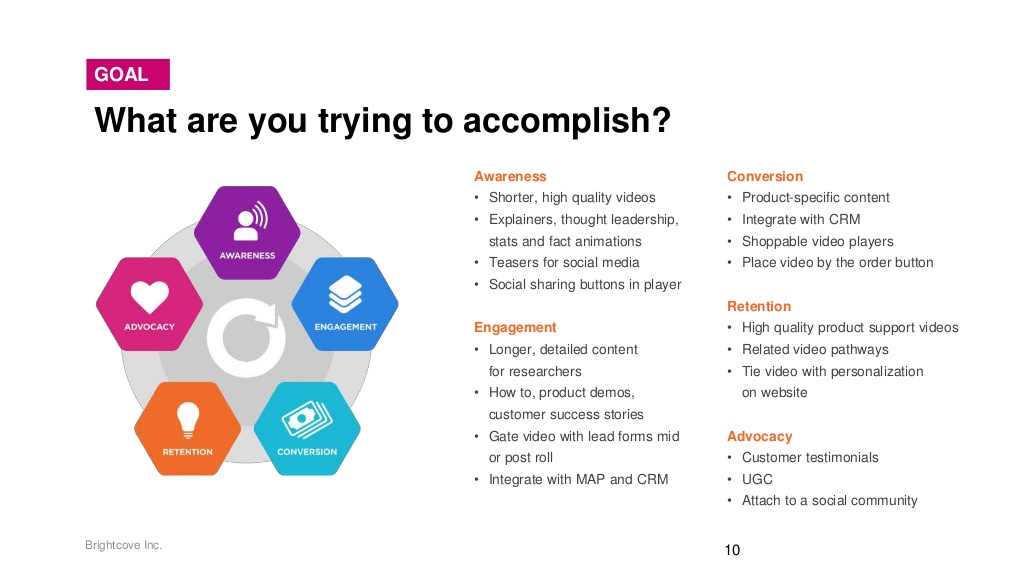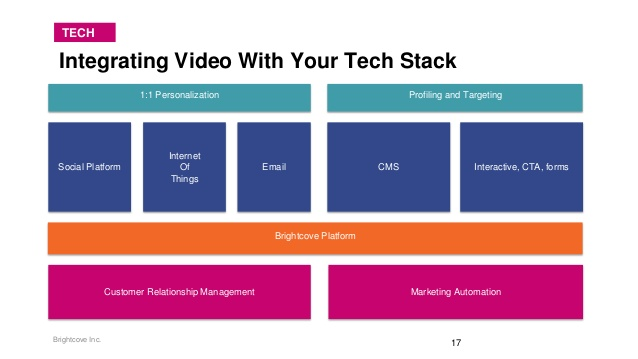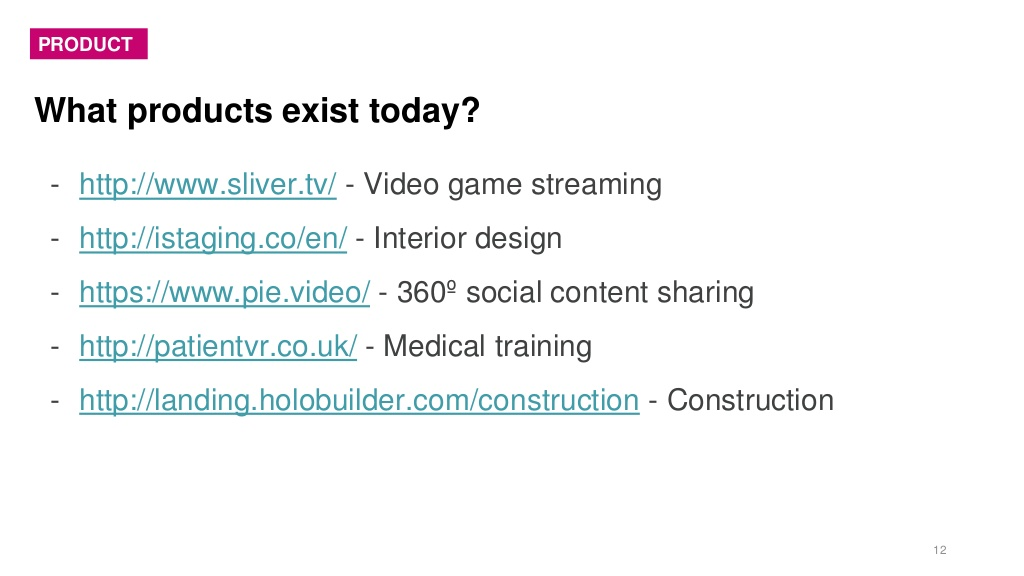Are you trying to drive business results? Do you produce video content for sales and marketing? Not surprising, 150,000 people had this goal in mind when they attended the 2016 Dreamforce conference in San Francisco. Brightcove presented on the topic of driving ROI from video marketing investments. Below is a transcript of our presentation where we discuss how to get started making simple, inexpensive videos and measuring the impact of those videos through integrations with marketing automation platforms (MAP), and of course, CRMs like Salesforce. Check it out.
Edited presentation transcript below
Why Do We Care About Video in Marketing?
So video’s important because everyone’s watching it. There are billions of views. Almost 79 percent of the bits and bytes that go through the internet of tubes are for video.
When it comes to marketing, people will buy things because of video. We’re getting back to the money part. We see about 150 percent boost from search engines. This is using SEO and video together.
We see 100 percent increase on time of site when you make video available on landing pages. We usually see up to double conversion if you’re using video on landing pages than without it.
Now if we really think about it, video is one of the most powerful mediums in the world. It changes our minds. It drives actions and we can measure it. There is no other medium that is like this. It is truly unique.
So where is video used in the customer journey? Who has seen a funnel before? Does this look familiar? Raise of hands. Funnel. Funnel. Funnel.
We don’t really want funnels anymore. We have a new concept and it’s the customer journey. This is a lifecycle, right? So we still enter at the top through awareness, but that we have all these different stages.
The Untapped Value of Video for Retention
So, awareness videos. These are called explainer videos and they literally explain who you are. Teasers on social media are another way that you get people to start to understand what you do. These are the types of video marketers are most often well associated with and want to get started with.
For retention, you’re gonna use a completely different type of content; a support video. Let me tell you, when people watch support videos they are boring. They’re not supposed to be entertaining. It’s not a teaser video. It’s a support video because it’s solving a problem.
These are two critical points in the customer journey. One of them costs you a lot to make, because making a fancy explainer video for Twitter is not cheap. The other one is free. You can make support videos today on your computer on your phone that drives your business forward.
Do you wanna retain your existing customers? Do you wanna on-board customers more efficiently? Once you know that goal, then we’re gonna pick what is the type of content that helps with this.
So let’s focus on a support video, for example.
Make a Support Video in 30 Seconds
Support videos just happen to be the easiest ones to make. If we look at how it goes down the scale here, testimonial videos are pretty easy to make, too. They’re very powerful. When we get to explain our teaser videos, those are a bit more involved. They take a little bit more energy to do.
So who has a Macintosh computer? Anybody? Did you know that you have a free screen test recording tool on your computer today right now? QuickTime Player, you think it’s just a player. Not true. If you click on File, New Screen Recording, boom. You will create an MP4 file.
I will in front of your eyes record a 30-second support video that will help convert a customer. Are you guys ready for this? I’m gonna open up the QuickTime player. I’m gonna do a new screen recording. I’m gonna press Record. I’m gonna click and it does the entire screen. So now I’m recording the video.
I’m gonna say, “Hey folks, let’s see a sample of how to send a video from within Salesforce.” Let’s click on this wonderful woman here who happens to be my wife. Salesforce is gonna ask me to login. I’m gonna login for a second. It’s an important part of the tutorial. How do you log in? Find the appropriate contact and I’m gonna send a video.
I could upload this right now to a support site and I guarantee you, if someone is interested in your product they will watch this video and they will be willing to give you their contact information for it because you’re helping them solve a problem. We made that in 30 seconds.
So if you think you don’t have video content, open up your computer and press the Record button because you have everything you need today.
There are other tools that are very, very effective that are on your mobile phone today. This is a cheesy, little app that creates videos that look like they’ve been taped on a VHS recorder-- they’re great videos for social media. Seriously. People love it.
Another example of technology that will let you quickly create video and get customers engaged, is an app called Videolicious. So this app will compile together clips from your phone automatically into a full, comprehensive video. So this is great for making an explainer video. So I can just go right there. I’m gonna choose a couple videos.
This can be anything that you have in your library. This could be videos. This could be photos. I’m gonna pick two or three that I know are really good here.
Step number two: tell my story. So then load the camera. Three, two, one. Hey, this is Kieran at Dreamforce. We have seen some really cool VR technology and we saw this crazy, blue monster and that is awesome. Stop. Instantly it’s gonna edit that together in front of your eyes. This already inputs our own logo at the beginning and has me doing the voiceover as I click on each clip, it’s been inserted in this video automatically. If you were able to hear it, you’d hear my voice over that I just recorded.
So in five minutes we have created two videos that can drive sales today. You can do this in your pocket or on your computer.
So now here’s the critical next step. Let’s say you do that. What do you do with it? Where do we publish this stuff?
Where to Publish Your Video Marketing Content
For your teaser video, your explainer video like the one I just recorded, Facebook is becoming one of the top destinations for video viewership. Make sure you have captions because people watch Facebook social video on mute.
Your own website is one of the most critical tools that you’re probably missing out on to publish your own video. YouTube, Instagram, sending video through e-mail and Twitter. These are all tools that you would upload that video to, but not in the same way. Let me explain it.
If you’re doing an explainer video you’re gonna post a small clip to Instagram. You’re gonna have a link that goes back to your website. You’re gonna do the same thing on Twitter. On Facebook you’re gonna have a version that’s half as long. You’re gonna put some captions on it. Boom. That’s your Facebook video.
Now your end goal, you wanna get everyone here to your own website. Why? Why? Make money. That’s the theme, right. We wanna make money. How do we get people to convert? They’re probably gonna convert on your website; not somewhere else ‘cause Facebook wants to sell them ads; not sell them your product.
So we wanna get them to your website. That’s where tools like Brightcove help you manage who’s watching, how much are they watching and then connect that information to your Salesforce instance, Marketo, Hubspot, Pardot, anything you want.
Then what you are able to do is to track hey, is this stuff actually working. So instead of hearing some guy like me say you should produce some support videos, produce a support video, make sure you measure it and put a lead generation form using our technology and then you see – are you driving leads from it or not?
This is an exercise that you guys can do – in about 30 minutes. You can do it today.
Setting Up a System to Evaluate Video Marketing ROI
So let’s talk a little bit about how this technology fits inside of your metrics, your reporting. So what does your boss want here?
Now your goal is probably not to get fired. You wanna get promoted. You wanna be successful. The way we do that is through metrics. So that’s why we go through the trouble of integrating video with our marketing automation suites, with our CRM’s like Salesforce.
Now all of us when we think about video think about the play count. That’s wrong. This is a proxy of how well it’s doing, but this is not what you want. What you really want is a conversion event. You want people to give you their identity, whether it’s an e-mail form, a LinkedIn form, whatever it may be and then we wanna make sure that the content that we’re showing them is relevant to help them go further down the funnel to become a customer.
So I get very frustrated when I hear people talking about they got 50,000 plays on YouTube. Well what does that get you?
Further Reading: “The High Cost of Free”
I can’t use YouTube credits to buy coffee. I don’t know about you guys, but my CFO does not like YouTube plays. He wants people to become customers. That’s the critical difference between the social video platform and what companies like Brightcove do to actually measure your video results.
Once we know who the viewer is, then we get to engagement. How much are they watching? What content are they watching? Then we’re able to send them targeted messages because we know they’re looking at a certain product or service.
Now how does that connect to your marketing tech stack? So what we like to look at is what’s the story from the customer’s journey. So one option is that you do one-to-one personalization. So using our new Salesforce plug-in you can target specific recipients and change the content of the video to match what their organization does, to have their name entered; all this stuff, directly from the emails you send from Salesforce.
Further Reading: 1:1 Conversations with Video
In order to make that happen you need to integrate some sort of video platform, like Brightcove, in your CRM and your marketing automation system. This then gets us access to see who are the contacts you guys can send e-mails out to. You’ll use your social platform or your e-mail platform in order to do that sending. The viewership and engagement activity is tracked within the Brightcove system and then it can go into your CRM system or your marketing automation system.
These visitors, they’ll be profiled or they’re targeted depending upon the content that they’re watching. You could use a lead form to identify who they are. By integrating video with Wordpress or integrating video with Sitecore you can map how content performs through your CMS. Our platform then provides the video delivery and measurement. Then it goes back into your marketing automation or customer relationship management software.
But it’s not just our part of the equation. It’s important that all these tools connect together. So like I showed you some of these video tools earlier, all of those tools connect into the Brightcove ecosystem.
The whole goal here is that we have one simple process for you guys to be able to create content, to post this content, to promote it through social media, to measure the engagement and then tie it back into the sales and user customer journey to help them retain afterwards.
How to Approach Video Marketing ROI: 3 Steps
So let’s say the goal is retention. One of the best ways to retain a customer is to make sure they go through a proper on-boarding procedure. What is the content that’s necessary to make this happen? That is the support video we just made, that is on-boarding content. It’s showing people how to use this system or product.
You deliver that in an environment where you can track people’s progress. So using tools like Brightcove Gallery, you can actually see what customers are watching this and how far do they get through this content.
The next step is that we tie this video to marketing automation and create triggers in Salesforce, we say, “Hey, if a customer opportunity has closed and it’s been 30 days and they have not engaged in any content, that’s a red alert.” The account manager should reach out to them as soon as possible to say, “Look, you haven’t even gone through the free on-boarding process that we provide on our website. What’s going on?” That is one of many ways that you could start to create a strategy around this.
So again, the next step for you guys is to be clear about what your goals are. What are you trying to do?
Number two is what is the content that you need in order to accomplish those goals.
Number three then is what are the systems that you need? Where are you gonna find the customer and then we need to deploy them. So integrate them with your CMS, your CRM, your MAP and all sorts of other gobblety-goop in the alphabet.
Closing notes and post-session questions posted below.
Video Marketing FAQ
I have a 100 company videos, but I don’t know what to do with them. Do you have any ideas?
So a lot of companies have tons of footage on your corporate network already. You have webinars. You have Skype sessions that you’ve recorded internally as training content. You can take all this content and put it into what’s called a gallery. So you can use that historical video content for internal training and knowledge sharing across your enterprise. So inside of your firewall. Or you could use that for external purposes for marketing and advertising.
Those systems then can then drive leads, drive conversions and then we can track what are people actually watching. So dust off those hard drives with the webinars on it. That could be some of the best converting content that you have.
How can I make more engaging video content?
What a great question. What are the best ways to have engaging content? It should be short. It should focus on one simple message.
Ideally there’s a very clear call for action. So at the end of the video you want someone to do something. Now a traditional call to action is text on the screen that says do something. A better call to action is interactive video. So through Brightcove interactivity – -- you can actually put calls to actions, purchase materials, et cetera, directly inside of the video content itself.
So it really goes across the spectrum. When you look at interactivity you can add all sorts of cool stuff. Then you can also measure them.
What is the business impact of virtual reality and 360 video?
So can you guess what are the three industries where you make a lot of money right now? Real estate: So architecture, building, construction, real estate and some travel and tourism. That’s where as a small business I can make content today. I can publish with a system like Brightcove and I can make money today. Customers are doing that now.
Learning may be one of the next steps. So if you talk to a company like FedEx or UPS, believe it or not, their trucks are not cheap and they don’t like people to crash them. Before they put someone in the seat of a truck they would like people to be able to see how do they use the truck. There is no better way than actually being inside of a virtual truck. Where is the parking brake? Where is the horn? I think that’s an easy one.
We’re already seeing some uses of 360 degree for medical, both for medical training and for reporting of content for either internal use at a medical facility or for training purposes afterwards.
One of the cool things right now is that you can already get off the shelf cameras that do 360 VR video for less than $500. On the consumer side, there’s expected to be roughly 80 million devices total shipped this year that are VR and 360 capable. So a lot of them are smartphones that you can get adapters for that have sufficient hardware, but then we also have the fancy head mounted displays. PlayStation is launching their VR headset this year. They’re putting tons of money behind this expecting around six millions to ship worldwide.
We’re then gonna see about two million estimated from HTC, just shy of a million or so from our friends over in Facebook with the Oculus. So we’re looking at somewhere between 70 and 80 million people that have the capability to view this content.
Are there products that exist today? There are products that are focusing on these specific verticals. Construction, building, content sharing, medical training. I would advise you to check them out if they are of interest to you.





